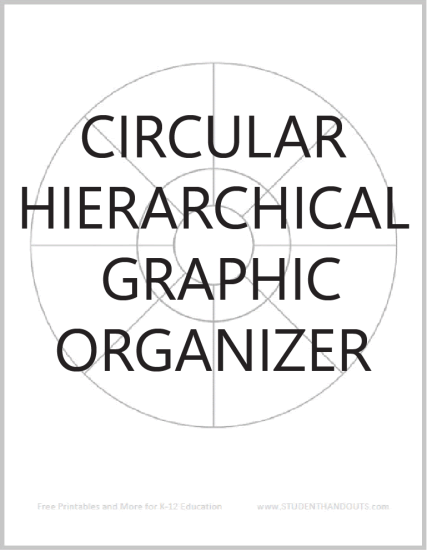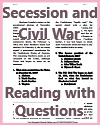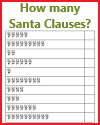This free printable graphic organizer template can be used in any number of ways. For example, students could write "Eight Parts of Speech" in the center, then the names of the parts of speech in the smaller sections, then examples of each in the larger sections.
Click here to print.
Click here for just the JPG image of the graphic, to use on your own worksheets or projects.
A circular hierarchical graphic organizer is a visual tool that arranges information in a circular, radial pattern with a central idea at the core and related concepts branching out in a hierarchical manner. This type of graphic organizer offers several benefits for both students and educators.
For Students:
- Visual Organization: Circular hierarchical organizers provide a clear and visually appealing way to organize information. They help students see the relationships between the main concept at the center and its subtopics or details radiating outwards.
- Hierarchical Structure: This type of organizer emphasizes the hierarchical structure of information, making it easy for students to distinguish between primary ideas and supporting details. They can quickly identify what is most important and what is less so.
- Conceptual Understanding: Students can better grasp the hierarchy of concepts and understand how various subtopics relate to the central theme or main idea. This promotes a deeper understanding of the subject matter.
- Brainstorming and Idea Generation: Circular hierarchical organizers are great for brainstorming sessions. Students can start with a central concept and then brainstorm related ideas, leading to creative thinking and idea generation.
- Study Aids: Students can use these organizers to summarize and study complex topics. By creating a visual representation, they can condense large amounts of information into a format that is easier to review and remember.
- Content Structure: When working on essays, reports, or presentations, students can use this type of organizer to plan the structure of their content. It helps them arrange their thoughts in a logical and organized way.
- Critical Thinking: Working with circular hierarchical organizers encourages students to think critically about the relationships between concepts and the hierarchy of information. It promotes the development of analytical skills.
For Educators:
- Effective Instruction: Educators can use circular hierarchical organizers to present information in a structured and engaging way. This visual aid can enhance the effectiveness of teaching and ensure that students grasp the key points of a lesson.
- Content Planning: Educators can use these organizers for planning curriculum and lessons. They help map out the hierarchy of concepts and identify the core content to be covered.
- Assessment and Evaluation: Teachers can design assessments and quizzes based on the organization of information in the circular hierarchical format. This allows them to assess students' comprehension and ability to see relationships between ideas.
- Differentiation: Circular hierarchical organizers can be adapted to suit different learning levels and styles. Educators can create more complex organizers for advanced students and simpler ones for those who need more support.
- Visual Aid for Presentations: When delivering lectures or presentations, educators can use circular hierarchical organizers to visually guide students through complex topics. It aids in making the content more accessible.
- Collaborative Learning: Educators can promote collaborative learning by having students work together to create circular hierarchical organizers. This encourages peer teaching and the sharing of knowledge.
Circular hierarchical graphic organizers are versatile tools that serve as effective aids for organizing information, promoting critical thinking, and enhancing the teaching and learning process. They are particularly useful for topics with complex hierarchical structures or when a visual representation can facilitate better understanding.
|













